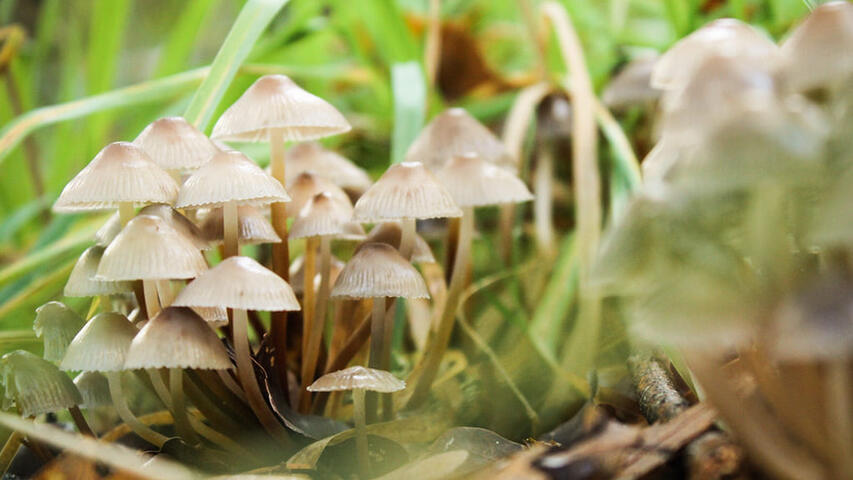It's mushroom time in As Rías Baixas
In the mountains of the province of Pontevedra we can find a great diversity of mushrooms. Take a look at the "top 10" edible mushrooms and enjoy the Rías Baixas mountains this autumn.
The search for wild mushrooms is an activity that is becoming more and more popular, not only for the culinary pleasure of tasting the freshly picked product, but also for the experience of going out into the mountains in autumn, in the company of family or friends.
In Pontevedra it is a relatively recent pastime, with a tradition dating back to the 1970s.
Among the most commonly collected edible species in Pontevedra, we present in alphabetical order the "top 10" mushrooms, both for their quality and their easy recognition. All of them have culinary applications and are a delicacy for mushroom lovers.
A great diversity of mushrooms grows in the mountains of the province and edible varieties can be found almost everywhere. However, there are classic collecting areas, which have become essential places for mushroom hunters due to their high production and accessibility.
Among the most visited mountains are, for example, O Vixiador, in Candeán, and the mountains around the University of Vigo; the area around Lake Castiñeiras, in O Morrazo; Mount Castrove, between Meis and Poio; the coastal pine forests of the region of O Salnés (Sanxenxo, O Grove and A Illa de Arousa) and, in the interior of the province, the banks of the Ulla and the oak and chestnut groves of Lalín, Silleda and Forcarei.
In fact, in the province of Pontevedra it is a relatively recent pastime whose tradition does not go back further than the 1970's. The daughters and sons of those first pickers now make up the second generation of mushroom hunters. The daughters and sons of those first pickers are now the second generation of mushroom foragers and it is they who have made an effort to spread the pleasures of mycology among the general public.
The species of mushrooms most commonly collected in the province are boletus, chanterelles, cat's tongue, milk cap and zarrota.
Take your basket and delve into this fascinating world. And, while you're at it, enjoy the richness of the flora and fauna that Rías Baixas offers us in this autumn season.
Where to seek advice?
Knowing how to identify edible mushrooms is essential if we want to avoid the dreaded poisoning. For this reason, many associations organise mycological conferences during these months, in which theoretical and practical lessons are given on how to collect and recognise mushrooms. At present, in the main towns of the Rías Baixas there are several groups dedicated to teaching and promoting the world of mushrooms, such as Brincabois, in Pontevedra; Liboreiro, in Bueu; A Cantarela, in Vilagarcía de Arousa; A Zarrota, in Vigo, and A Estrada Micolóxica.
1.Agaricus campestris
Also known as wild mushroom or fungo dos lameiros in Galician. It is a small, white mushroom. It grows both in spring and autumn in rich, well-fertilised meadows and gardens.
Boletus edulis group boletus
This group includes four very similar edible species, Boletus edulis, Boletus aestivalis, Boletus pinophilus and Boletus aereus. They are brown in colour and usually grow in hardwood or coniferous forests. In Galician they are also called andoas.
3.Cantharellus cibarius and Cantharellus pallens
These are two very similar species. In As Rías Baixas they are known by the popular name of cantarelas and their shape resembles that of a trumpet. The colour depends on the characteristics of the soil where they grow, although it usually varies from whitish yellow to orange.
4.Coprinus comatus
Also known in the province as "chipirón de monte", due to its shape. It has a very characteristic elongated cap and grows in meadows, gardens and grasslands.
5.Craterellus tubaeformis
In the Rias Baixas it is known as the wild elver, as when cooked the foot of the mushroom is reminiscent of this fish. It fruits in deciduous forests, pine forests and eucalyptus groves, well into autumn, when temperatures drop.
6.Hyndnum repandum
Also known as the cat's tongue or cow's tongue, it is a late mushroom which, like the previous one, comes out late in autumn, from November onwards. It is cream-coloured and can be found in hardwood, conifer and eucalyptus forests.
7.Lactarius deliciosus
It is called níscalo and in some areas of Galicia fungo da muña. It is a highly appreciated mushroom in gastronomy and, in fact, many collectors only focus on this species. It fruits in pine forests and has a very characteristic colour and orange latex.
8.Macrolepiota procera
Also known as Zarrota, monxo or choupin. It is distinguished by being tall and slender and its cap can reach 40cm in diameter. It grows in well-lit woods, meadows and well-fertilised soils.
9.Neoboletus erythropus
Formerly known as Boletus erythropus. It is a boletus-type mushroom, with a brown cap with red pores and yellow flesh that turns blue on contact with air. Its habitat is hardwood and coniferous forests.
10.Trincholoma portentosum
Known as tortullo, it is a mushroom with a grey cap and a whitish foot with pale yellow tones. It grows in pine forests when the cold weather arrives, from November onwards.
You can't miss it...
- O Vixiador
- Mount Castrove
- Oak groves of Lalín
- Castiñeiras
